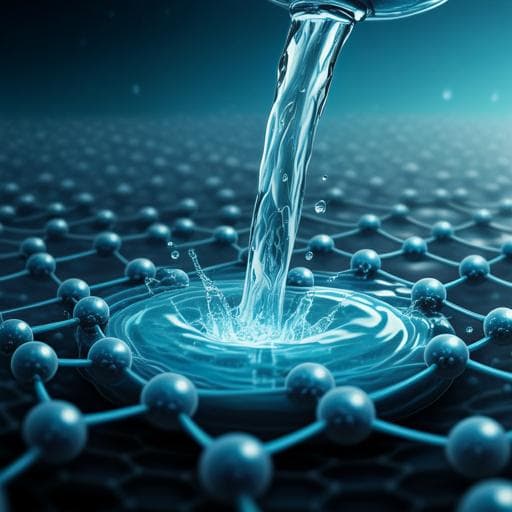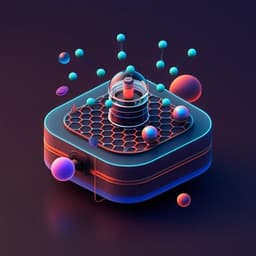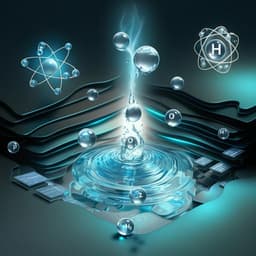
Engineering and Technology
Anomalous water molecular gating from atomic-scale graphene capillaries for precise and ultrafast molecular sieving
Q. Zhang, B. Gao, et al.
Discover a groundbreaking solution to the global clean water crisis! This research unveils advanced nanofiltration membranes that achieve both exceptional ion sieving and ultra-high water flux, revolutionizing water purification methods. Conducted by an expert team of researchers, this study paves the way for precise and ultrafast molecular sieving techniques.
~3 min • Beginner • English
Introduction
The study addresses the long-standing challenge in membrane-based water purification of achieving precise ion sieving while maintaining ultrafast water flux. Conventional hydrophilic nanofiltration membranes with sub-nanometer channels (e.g., graphene oxide and MXene membranes) can reject ions by Coulombic interactions but suffer reduced water transport due to steric resistance and hydrogen bonding with oxygenated walls. Reduced graphene oxide membranes can provide fast water flux but typically lose atomic-scale capillaries due to restacking, resulting in poor ion sieving. Thermal-coupled approaches (membrane distillation, pervaporation) can enforce water vapor transport through atomic-scale capillaries but with higher energy costs. Inspired by biological ion channels with precise, fast gating, the authors propose a membrane that selectively and rapidly gates water transport while suppressing ion diffusion at ambient temperature, leveraging atomic-scale graphene capillaries (~6 Å) to overcome the conventional trade-off.
Literature Review
Background work highlights hydrophilic 2D membranes (GO, MXene) that enable ion sieving by tuning interlayer spacing but impede water flux via steric and H-bond interactions. Reports of frictionless water flow in atomic-scale graphene capillaries (contact angle ~85°) point to potential for overcoming this trade-off, yet rGO membranes typically restack and seal atomic-scale capillaries, leaving larger graphitic pores that degrade ion sieving. Thermal-membrane hybrid processes applied to GOMs enable vapor-only transport through atomic-scale graphene capillaries but raise energy consumption concerns. Biological ion channels provide a paradigm for fast, selective gating, suggesting the desirability of gating water molecules rather than ions for water–ion separation. The small size difference between water (~2.7 Å) and hydrated alkali-metal ions (>6.6 Å) makes fast water gating without sacrificing ion rejection particularly challenging.
Methodology
- Synthesis of 2D island-on-nanosheet heterostructure: Oxygenated functional groups on GO (covering ~40–50% area) were used as catalytic sites to grow a metal–organic material, Ni-p-phenylenediamine (Ni-pPD), forming Ni-pPD monolayer islands uniformly distributed on rGO (Ni-pPD@rGO). Characterization included STEM-EDX mapping (homogeneous C, Ni, N distribution), FTIR (C=N, aromatic C=C, C–N, N=Q=N features; reduction of GO), XPS (C 1s, N 1s features consistent with Ni-pPD and GO reduction), and zeta potential (−33 mV for GO to −10 mV for composite) confirming reduction to rGO and successful island growth.
- Structural modeling: DFT optimized microstructures showed Ni-pPD planarized via π–π stacking on rGO. HAADF and HRTEM evidenced 2D amorphous Ni-pPD islands on rGO.
- Creation of atomic-scale capillaries via spontaneous restacking: AFM thickness ~2.88 nm indicated three repeating units (~0.96 nm each). HRTEM of edges showed interlayer spacing ~0.96 nm between neighboring rGO. DFT of repeating units showed two Ni-pPD layers pillared between rGO with stacking distances 0.34–0.36 nm. Free spaces inferred: 2.6 Å (between 1st rGO and 3rd pPD) and 6.2 Å (between 1st and 4th rGO), enabling atomic-scale graphene slit capillaries.
- Membrane fabrication: Micrometer-thick membranes (MOGMs: metal–organic pillared graphene-based membranes) were prepared by vacuum filtration followed by controlled evaporation under external pressure. SEM/EDX (top and cross-section) confirmed dense packing and uniform composition.
- Wetting and crystallographic characterization: Water contact angle 84° for MOGMs (vs. 44.5° for GOMs), indicating graphene-like capillaries. XRD for MOGMs showed (002), (004), (006), (008) peaks with interspacings consistent with repeating-unit restacked structure (e.g., (002) ~0.93 nm, (006) ~0.32 nm).
- Porosity analysis: BET/NLDFT using N2 (micropores >1 nm) and CO2 (ultra-micropores <1 nm) revealed distinct sub-nano peaks with a strong ~0.6 nm mode, consistent with the ~6.2 Å capillary free space predicted by DFT.
- Permeation testing under forward osmosis: U-shaped cell with 0.1 M salt draw solutions (KCl, NaCl, MgCl2). Hydrostatic height differences applied at ~10−2 bar scale. Water flux measured and ion permeation quantified (ICP-MS); GOMs used as controls.
- In-situ FTIR under controlled humidity (37%–100% RH): Monitored OH stretching, bending, and libration bands to infer hydrogen-bond network strength inside capillaries versus bulk water; Gaussian deconvolution into five components correlated with average H-bonds per H2O.
- Atomistic simulations: DFT optimized water arrangements in 6.0 Å and 8.7 Å graphene capillaries; density and coordination assessed. MD simulations of permeation under osmosis constructed to analyze ON/OFF states and transport mechanism (details in Methods/SI).
Key Findings
- Precise capillary size control: Restacked Ni-pPD@rGO forms atomic-scale graphene slit capillaries with free space centered near 6.2 Å (DFT) and pore size distribution showing a sharp peak ~0.6 nm (BET/NLDFT). Interlayer spacing ~0.96 nm verified by AFM/HRTEM; XRD supports repeating-unit stacking.
- Hydrophobic graphene-like channels: MOGM water contact angle 84° (vs. GOM 44.5°), consistent with atomic-scale graphene capillaries that support frictionless-like water flow.
- Anomalous gating behavior under osmosis: In a U-cell with 0.1 M MgCl2 (osmotic pressure ~7.4 bar), with zero hydrostatic head (OFF), no water flux detected over >1 day, implying suppressed diffusion. Applying a small hydrostatic pressure of 7.8 × 10−3 bar (gating pressure), water flux jumped to ~0.71 L m−2 h−1 and increased to ~2.5 L m−2 h−1 at 9.8 × 10−2 bar (ON). Water flow exceeded diffusion-limited estimates by >2 orders of magnitude. Water transport is reversibly switched ON/OFF around PG ~10−2 bar.
- High flux with strict ion sieving: Across tests and salts, water flux achieved 2.5–45.4 L m−2 h−1 while ion permeation rates were negligible, ~10−10 mol m−2 h−1; for Mg2+ at 10 cm head, ion flux fell below ICP-MS detection. Ion permeation in OFF state decreased with increasing hydrated ion size, implying size exclusion and partial dehydration with high activation barriers.
- Confined ordered water structure: In-situ FTIR bands (stretching, bending, libration) red-shift with decreasing humidity, indicating stronger H-bonding within capillaries than in bulk. Deconvolution shows predominant components corresponding to 4- and >4-coordinated H2O at 37% RH. DFT reveals a 2D close-to-hexagonal monolayer of ordered water in 6.0 Å capillaries (HB per H2O ≈ 4–5) with density ~2.2 g cm−3; at 8.7 Å, a double-layer hexagonal arrangement also with ~2.2 g cm−3.
- Mechanistic implication: The graphene nanoconfinement induces a solid-like, highly H-bonded water network that hinders diffusion under osmotic driving yet enables rapid, diffusion-free, pressure-gated bulk flow, analogous to Newton’s cradle-like Grotthuss-style conduction.
Discussion
The work demonstrates that atomic-scale graphene capillaries (~6 Å) can reconcile the traditional trade-off in nanofiltration by selectively gating water flux while suppressing ion diffusion. In the OFF state, the solid-like, highly connected hydrogen-bond network within the confined graphene slit inhibits both water and ion diffusion despite large osmotic pressures. In the ON state, small hydrostatic pressures (~10−2 bar) trigger high-speed, diffusion-free bulk water transport, delivering fluxes orders of magnitude above diffusion limits while maintaining negligible ion permeation. Compared with conventional GOMs, which show osmotic diffusion and limited selectivity/flux balance, the MOGMs achieve reversible gating, precise ion sieving (including size-exclusion and partial dehydration effects), and ultrafast water transport at ambient conditions. The findings support a liquid–solid–liquid phase-changing transport mechanism under graphene nanoconfinement and suggest applicability to other NF systems (e.g., MOF/COF membranes), offering a path to energy-efficient, high-performance water–ion separations.
Conclusion
The authors present metal–organic (Ni-pPD) pillared rGO membranes (MOGMs) featuring atomic-scale graphene capillaries primarily around 6 Å that deliver reversible, pressure-gated water transport with ultrafast flux alongside strict ion sieving under forward osmosis. Structural characterization (AFM/HRTEM/XRD/BET) and atomistic simulations (DFT/MD) confirm ordered, dense, hydrogen-bonded water within the confined graphene slits, which suppresses diffusion but enables rapid bulk flow upon small hydrostatic pressures. Experimentally, water fluxes of 2.5–45.4 L m−2 h−1 are achieved while ion permeation rates are suppressed to ~10−10 mol m−2 h−1. This establishes a liquid–solid–liquid phase-changing molecular transport paradigm and a practical route to precise and ultrafast molecular sieving at ambient temperature. The underlying mechanism and fabrication strategy could be extended to other nanofiltration membranes (e.g., MOF/COF-based) and inform next-generation desalination and water purification technologies.
Limitations
Ion diffusion is highly suppressed but not completely eliminated, particularly in the OFF state; size-dependent permeation implies partial dehydration and associated activation barriers rather than absolute exclusion. Edge carbon atoms and dangling bonds present in micrometer-thick membranes may introduce additional transport resistance (though FTIR indicates they do not prevent ordered water formation). The gating relies on applying a finite (albeit small) hydrostatic pressure differential, and detailed operational stability, scalability, and long-term fouling/robustness under realistic feed conditions are not fully addressed in the provided text.
Related Publications
Explore these studies to deepen your understanding of the subject.







